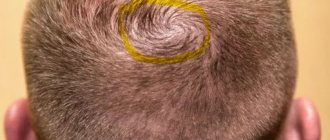- Published by: Laima Jansons
Complaints of headache occur in almost any pathology and can vary depending on the location and nature of the manifestation (burning, pressing, cutting, pulsating, etc.), duration, causes and many other parameters. Burning pain in the head most often develops due to cardiovascular or neurological pathology , less often the state of the endocrine system plays a role.
Photo 1. Headache cannot be ignored. Source: Flickr (C. Michael's Photography)
Causes of a burning sensation in the head
Burning pains often occur for various reasons; oddly enough, they have nothing to do with the head itself, but are most often caused by problems that are located in completely different areas, for example, with the spine or the cardiovascular system. The endocrine system also often lets you know about problems through burning pain localized in the head.
Cervical osteochondrosis
With osteochondrosis, pain can occur as a result of two parallel developing processes:
- Compression of the spinal nerves;
- Partial compression of the vertebral artery.
In sum, these two factors lead to disruption of blood supply and innervation, which is felt as burning, pressing pain . Most often they are diffuse in nature and spread over the occipital, temporal, and parietal regions.
Arterial hypertension
Hypertension and its complications are the most common disease among people over 40 years of age. For several decades, it has been a leading cause of death worldwide.
When pressure increases, especially during a hypertensive crisis, one of the main symptoms is tinnitus, pulsation and burning pain in the temporal, occipital, parietal, and frontal regions. Also, high blood pressure may be accompanied by a feeling of midges in front of the eyes, dizziness, nausea, vomiting, and loss of consciousness. Such conditions require immediate help , since they can provoke the development of a heart attack or stroke even in young people.
Vegetovascular dystonia
VSD is a disruption of the activity of the part of the nervous system responsible for the activity of internal organs, blood vessels, and glands. Headaches in this pathology develop as a result of dysregulation of the tone of small and medium-sized vessels . This can lead to excessive filling of the vascular bed of the meninges, spasm of individual vessels, and changes in blood pressure. Attacks of VSD are often combined with pallor or redness of the skin, the appearance of perspiration, nausea, and tinnitus.
Hormonal imbalance
Burning pains can bother women during the premenopausal period , when the hormone-producing function of the gonads gradually fades away and a significant restructuring of the body occurs. Pain syndrome is an integral part of the so-called. hot flashes, during which a woman may feel hot, cold, blurred vision and a number of other symptoms.
Photo 2. During menopause, women may experience headaches. Source: Flickr (Rima Nurmala).
Wrong lifestyle
The modern pace of life involves being under constant stress. Lack of sleep, lack of a proper meal schedule, and bad habits affect the state of the nervous system, which leads to the development of neuralgia, migraines, and cluster pain . In such a case, a burning sensation in the head can spread only to one half of the skull, occupy symmetrical areas, or cover like a hoop.
Such conditions can lead to a reflex rise in blood pressure, which will only worsen the general condition.
Note! A burning sensation in the head can also be a sign of glaucoma. During an acute attack, there is always an increase in blood pressure, which often contributes to the erroneous diagnosis of a hypertensive crisis and the prescription of incorrect treatment. Incorrect treatment of an acute attack of glaucoma can contribute to vision loss.
Feeling hot
Menopause
Diabetes
15039 August 24
IMPORTANT!
The information in this section cannot be used for self-diagnosis and self-treatment.
In case of pain or other exacerbation of the disease, diagnostic tests should be prescribed only by the attending physician. To make a diagnosis and properly prescribe treatment, you should contact your doctor. The feeling of heat that a person experiences occurs due to a sharp expansion and blood filling of small subcutaneous vessels. This condition is called arterial hyperemia. At the same time, the skin turns red and becomes hot.
The lumen of blood vessels is regulated by the sympathetic and parasympathetic nervous system. Its changes depend on signals from the vasomotor (vasomotor) center of the central nervous system, hormones, pyrogenic (heat-causing) substances entering the blood, and a number of other factors.
Types of sensations of heat
The vessels are constantly influenced by factors that have a vasoconstrictor or vasodilator effect. For example, under stress, blood vessels narrow under the influence of the hormone adrenaline, and the skin turns pale. At the end of the stressful situation, the vessels relax and fill with blood.
Pathological arterial hyperemia, which is accompanied by a feeling of heat, develops either under the influence of irritants (infections, toxins, tissue breakdown products from burns, pyrogenic substances), or due to a violation of nervous regulation.
There are
neurogenic
arterial hyperemia (occurring in response to irritation of nerve endings) and
metabolic
(caused by the action of local chemical factors). An example of neurogenic arterial hyperemia is redness of the face and neck during hypertension, menopausal syndrome, and also during strong emotions.
Blood electrolytes have a metabolic effect on vascular tension: calcium and sodium constrict blood vessels and increase blood pressure, while potassium and magnesium, on the contrary, dilate them. Metabolic regulators include carbon dioxide, organic acids, and hormones.
Possible causes of feeling hot
Hot, hot and spicy foods can cause a rush of blood to the skin and a feeling of heat.
Alcohol has the same effect on the body.
, which promotes the dilation of blood vessels.
Taking certain medications
can also cause a feeling of heat spreading throughout the body. These include vasodilators, hormonal agents, antidepressants, etc.
The causes of arterial hyperemia and, as a result, feelings of heat can be different. If the regulation of vascular tone is disturbed, arterial hypertension may develop, accompanied by a sudden increase in blood pressure - a hypertensive crisis. The most common cause of this condition is hypertension. However, in a third of cases, arterial hypertension is caused by diseases of the internal organs: acute glomerulonephritis and other kidney damage, adrenal tumors and other diseases of the endocrine system. The magnitude of the rise in blood pressure during a hypertensive crisis depends on the age and individual characteristics of the person. At a young age, symptoms of a crisis may occur at a lower level of blood pressure, and at an older age – at a higher level.
A sharp increase in blood pressure is accompanied by headache, dizziness, nausea, vomiting, visual disturbances (“floaters”, double vision). Possible numbness of the limbs, a feeling of pins and needles, rapid heartbeat, shortness of breath.
Due to a violation of nervous regulation, chills occur, followed by fever, and increased sweating. The end of the crisis is accompanied by frequent urination.
Increased blood pressure and the symptoms accompanying this condition also occur with an adrenal tumor - pheochromocytoma
and other hormone-producing tumors. The tumor secretes large amounts of catecholamines (adrenaline and norepinephrine).
Clinical signs of pheochromocytoma may include headache, sweating, increased heart rate, irritability, weight loss, chest pain, nausea, vomiting, weakness, and fatigue. In some cases, patients may experience fever, shortness of breath, hot flashes, increased thirst, increased urination, dizziness, and tinnitus.
Many women complain of hot flashes during menopause
. Changes in hormonal levels occur even before the cessation of menstruation, during premenopause (menopausal transition). At first, its manifestations are insignificant, and most often they are not given importance or are attributed to the consequences of fatigue and mental stress. Hormonal and metabolic changes, in particular, a decrease in the level of estrogen, progesterone and an increase in the production of GnRH, are accompanied by hot flashes, which can be repeated several times a day.
Women describe them as a periodic short-term feeling of heat followed by chills, increased sweating, and rapid heartbeat.
In most cases, hot flashes only slightly affect your well-being.
Arterial hyperemia and a feeling of heat can be a sign of dysfunction of the thyroid gland, for example, with thyrotoxicosis
. Patients with thyrotoxicosis complain of general weakness, fatigue, irritability, sleep disturbance, sweating, trembling fingers, palpitations, and sometimes pain in the heart area.
Despite the increased appetite, patients with thyrotoxicosis lose weight.
Violation of thermoregulation, which occurs due to accelerated metabolism, leads to an increase in body temperature and causes a constant feeling of heat. The skin becomes warm and moist, the skin vessels dilate, which is accompanied by redness of the face. Sweating increases, nails become brittle, and hair falls out.
Sometimes hot flashes and a feeling of heat in combination with high blood pressure occur with diabetes mellitus
. These symptoms are accompanied by general malaise, sweating, thirst, and an increase in the volume of urine produced.
Which doctors should I contact?
If symptoms such as fever and hot flashes appear regularly, you need to contact, who, based on the complaints and tests, will refer you to or.
Diagnostics and examinations
The appearance of periodic hot flashes, accompanied by a feeling of heat, sweating, and redness of the facial skin, requires mandatory diagnosis.
The doctor evaluates the patient's complaints, taking into account age, gender and concomitant diseases. When blood pressure increases, turning into crises, it is necessary to determine the nature of the pathology - primary (associated with a violation of nervous regulation) or secondary (due to diseases of the internal organs). For this purpose, a clinical blood test and a general urine test, a urine test according to Nechiporenko, a blood test for glucose, cholesterol, and creatinine are prescribed.
Nature of pain and accompanying symptoms
Burning, burning pain in the area of the brain or facial skull is almost always combined with other symptoms . The most common ones are:
- Dizziness;
- Noise in ears;
- Feeling of midges before eyes;
- Increased blood pressure;
- Nausea;
- Pallor or redness of the skin.
Various combinations of these manifestations, together with the pain symptom, its location and duration, create a clinical picture of a certain pathology.
Diagnosis of pathology
To determine the causes of a burning sensation in the head, the diagnostic process always begins with measuring blood pressure , since its increase is the most likely and common cause of this condition. In the future, consultation with a neurologist, endocrinologist and ophthalmologist is possible .
For diagnostic purposes, the following studies can be performed:
- X-ray of the cervical spine in two projections;
- Measuring intraocular pressure;
- Doppler examination of neck vessels;
- Determination of hormonal levels in women;
- MRI of the head and neck area.
Homeopathic treatment for symptom relief
The use of homeopathic medicines is appropriate in cases where emergency medical care is not required, such as in the case of a hypertensive crisis or an attack of glaucoma. The use of this group of drugs is appropriate for VSD, manifestations of menopause in women, and chronic stress.
- Acidum nitricum - indicated for pain in the head of a shingles nature;
- Phosphorus (Phosphorus) – helps with a burning sensation in the head with a feeling of a rush, due to prolonged stress;
- Ratania peruviana - used in case of pain of a pressing and burning nature;
- Xanthoxylon americanum - used for burning sensation in several areas of the head, flashing of midges before the eyes;
- Pulsatilla pratensis - indicated for any headaches due to overexertion, fatigue, stress.
The main causes of burning in the temples
What are the reasons for a burning pain in the head? There are many of them. More often, the feeling that the brain is on fire occurs in older people, but young people are also not immune to it.
Overwork, stress
Constant overwork and stress, caused by the depletion of the body's internal reserves, leads to negative consequences and diseases that can become chronic.
The tone of the blood vessels in the brain is disrupted, and difficulty in blood flow occurs, which is often manifested by burning skin in the back of the head and dizziness. Lack of oxygen leads to numbness in the limbs, sudden clouding of consciousness, darkening or fog in the eyes.
Cervical osteochondrosis
A common reason for a burning sensation in the back of the head and fire in the head and neck is osteochondrosis of the cervical spine. With pathology, intervertebral discs become deformed and become degenerative. This disrupts microcirculation, which leads to symptoms such as noise and ringing in the ears.
The disease rapidly progresses with sedentary work and a sedentary lifestyle. The patient feels numbness in parts of the face, tingling and burning in the neck and back of the head, and a crunching sound when rotating the head. When blood vessels and nerve endings are pinched, it can suddenly stagger when walking, causing dull and aching pain in the back of the head and heaviness.
Hormonal disorders
Hormonal imbalances do not go away without leaving a trace, causing many symptoms, including a burning sensation in the forehead and itching inside the head (it seems that the brain has begun to itch). If correction is not made, the consequences will be even more serious.
Mostly hormonal imbalance occurs in women during pregnancy, menstruation, and menopause. Hormonal levels are also affected by poor nutrition, heredity, excess weight, infectious diseases, psychosomatics, neurosis, and diseases of the endocrine system.
Arterial hypertension
A burning sensation in your head may indicate high blood pressure. Hypertension often develops in people who are regularly exposed to stress. In addition to the feeling that the top of the head is baking, the disease is accompanied by slight tingling in the crown and temples, dizziness, blurred vision, and nausea.
Bad habits
An unhealthy lifestyle in adult men and women - smoking, poor diet, addiction to alcohol, sedentary lifestyle - creates a situation where the body stops coping with its task.
The above factors negatively affect blood flow; blood accumulates in the head and causes a feeling that it is baking the head from the inside, under the skin.
Vegetative-vascular dystonia
Vegetative-vascular dystonia manifests itself with different symptoms. First of all, the blood supply is disrupted, so a burning sensation in the head is the main sign of the disease.
If VSD is accompanied by headaches and cryovascular syndrome, then the feeling of heat is complemented by tachycardia, increased blood pressure, and sweating.
Sympatho-adrenaline crisis
Sympatho-adrenal crisis or panic attacks also provoke symptoms of “burning skin”, “burning face”, “goosebumps in the head”. According to statistics, 2.5% of the world's population suffers from panic attacks. In severe cases, attacks last up to 8 hours and, in addition to the fact that the top of the head is burning, there is an increase in blood pressure, fear of death, chills, and shortness of breath.
Panic attacks do not only arise from nerves. They can be caused by a tumor of the spine, spinal cord, or adrenal glands.
Brain tumors
Symptoms of brain tumors vary and worsen as the tumors grow. Benign neoplasms grow slowly and may not manifest themselves for years. Malignant tumors grow rapidly and can cause many symptoms, including a burning sensation in the head.
If a person feels that his head is burning from the inside, pain is on the left side or on the right side, it is necessary to conduct a diagnosis of the brain. Along with pain, the patient may feel sick, vomit, shoot in the head, experience dizziness, stupor, apathy, impaired memory, coordination, mood swings, and may have a stuffy nose.
Signs depend on the location of the tumor. For example, a formation on the right side of the temple is accompanied by changes in hearing, smell, and taste. A tumor in the crown or occipital region causes pain in the limbs and a burning sensation in the upper part of the head.
Eye and hearing diseases
If your head hurts and burns, this may indicate diseases of the organs of hearing or vision. For example, a feeling of tingling and burning in the head, it is impossible to concentrate on one point, occurs with severe eye fatigue or decreased vision. And with some diseases of the hearing aid, the ears burn.









